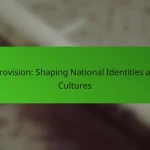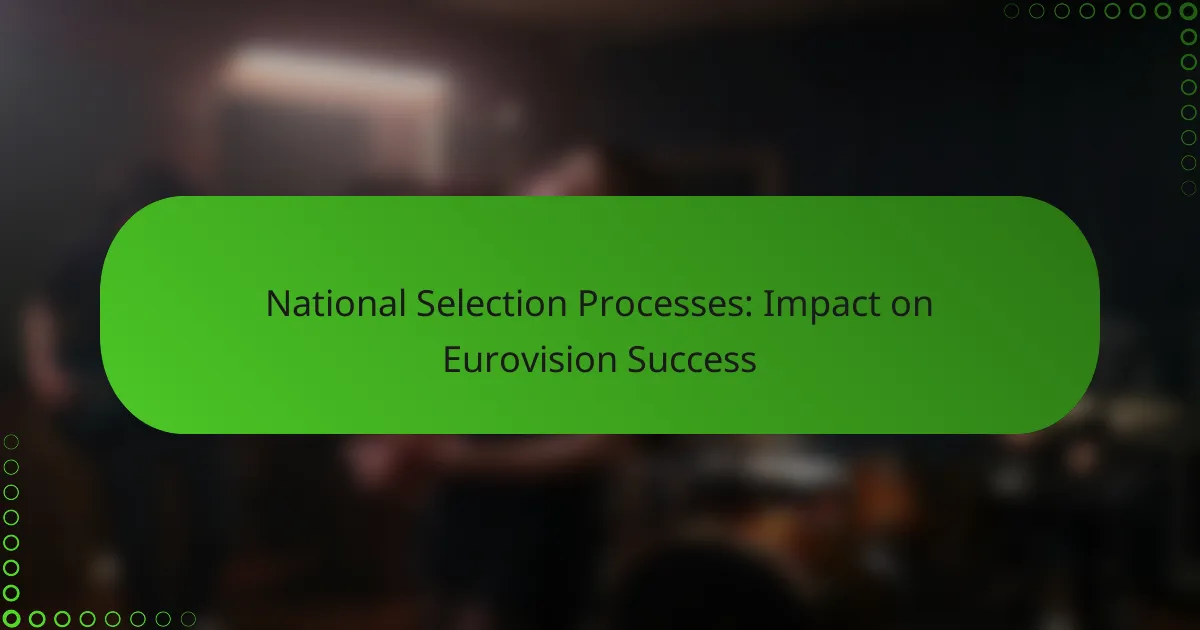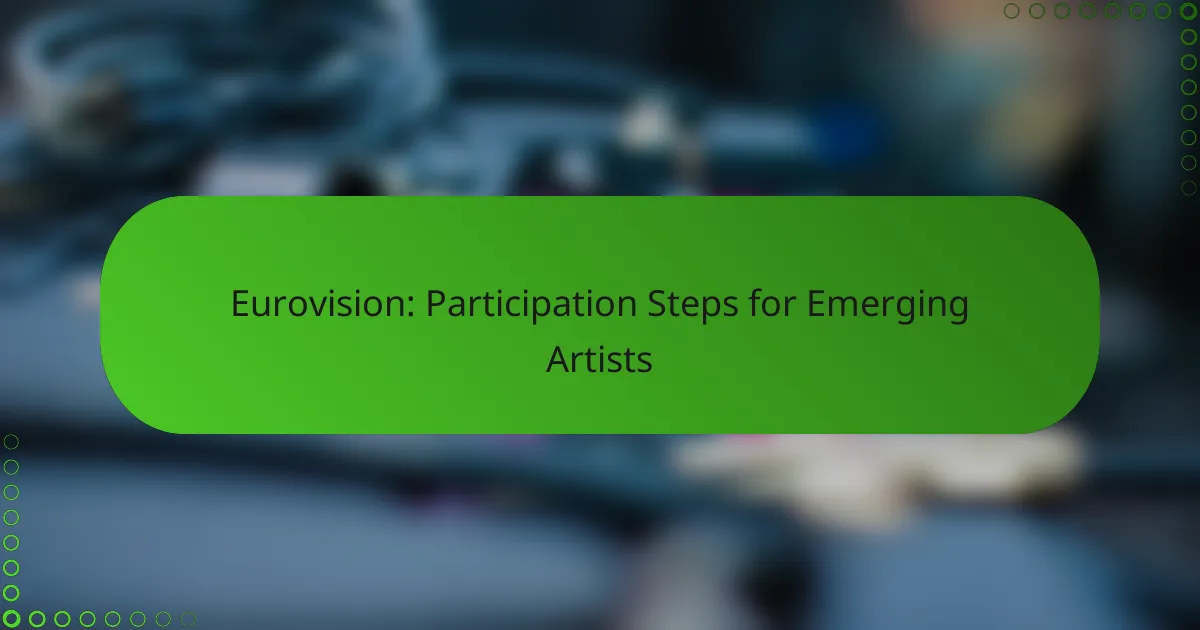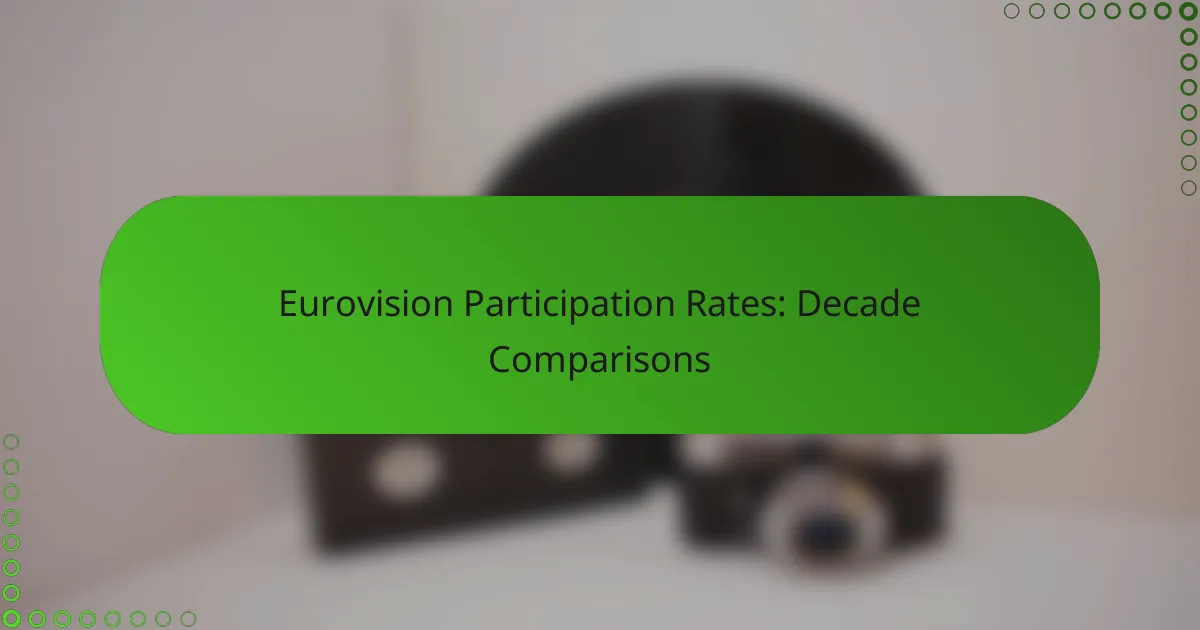National selection processes play a crucial role in determining a country’s success at the Eurovision Song Contest by influencing the choice of songs and artists. Various formats, such as public voting and jury involvement, shape how well performances resonate with international audiences, ultimately impacting the final results. Countries like Sweden, Italy, and the United Kingdom have honed their selection methods to enhance their competitiveness, often incorporating public participation and expert input to select standout entries.
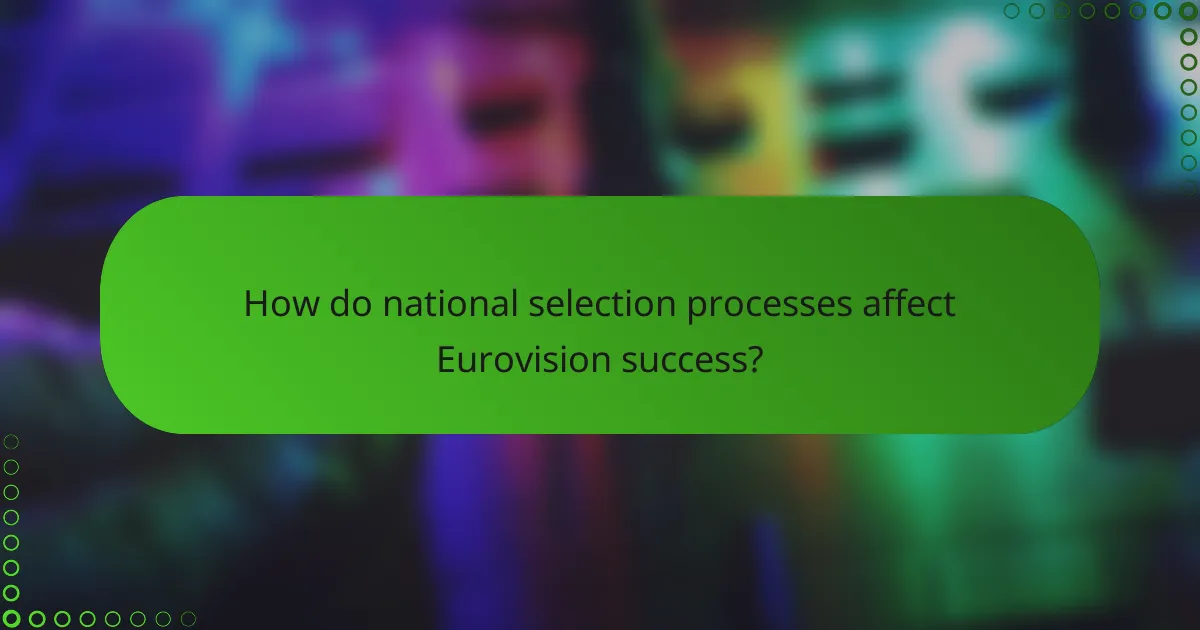
How do national selection processes affect Eurovision success?
National selection processes significantly influence a country’s success at Eurovision by determining which songs and artists represent them. The structure of these processes, including public voting and jury involvement, can shape the final outcome and impact how well a performance resonates with the international audience.
Impact of public voting
Public voting is a crucial element in national selection processes, as it allows fans to directly influence which entries advance to Eurovision. This engagement can lead to more popular and relatable songs being chosen, as public preferences often reflect current trends and tastes.
However, relying heavily on public voting can also lead to unexpected results, where less conventional or niche entries may be overlooked. Countries should balance public input with strategic considerations to ensure a competitive entry.
Role of professional juries
Professional juries play a vital role in national selection processes by providing expert opinions on the quality of performances and songs. Their insights can help elevate the overall standard of entries, ensuring that the selected song has artistic merit and stage presence.
While juries can enhance the selection process, they may also introduce biases based on industry standards. A well-rounded approach that combines jury feedback with public voting can create a more balanced representation of both artistic quality and popular appeal.
Case study: Sweden’s Melodifestivalen
Sweden’s Melodifestivalen is a prime example of a successful national selection process, known for its high production values and diverse range of entries. The competition features multiple rounds, allowing for extensive public participation and jury evaluation, which often results in strong performances at Eurovision.
Melodifestivalen’s format encourages innovation and creativity, making it a model for other countries. The blend of public and jury voting has consistently led to Sweden achieving top placements in Eurovision, showcasing the effectiveness of this dual approach.
Comparison with France’s national selection
France’s national selection process has historically been more centralized, with less public involvement compared to Sweden’s Melodifestivalen. This can lead to a disconnect between the chosen entry and the audience’s preferences, potentially affecting France’s competitiveness at Eurovision.
While recent reforms have aimed to increase public voting, the balance between jury influence and public sentiment remains a challenge. Countries like France can learn from Sweden’s model by incorporating more public engagement to enhance their chances of success at Eurovision.
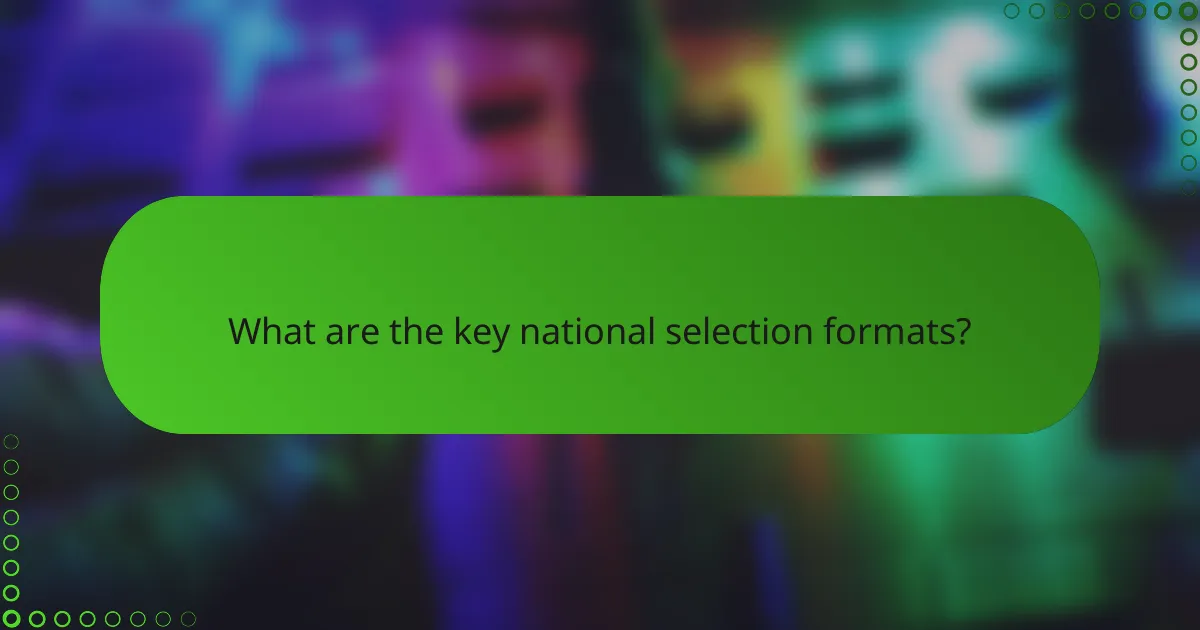
What are the key national selection formats?
National selection formats are the methods countries use to choose their representatives for the Eurovision Song Contest. The main formats include direct appointments, national finals, and a combination of jury and public votes, each with distinct processes and implications for success.
Direct appointments
Direct appointments occur when a national broadcaster selects an artist or song without a public selection process. This method allows for quick decisions and can ensure that a well-known artist represents the country, potentially increasing the chances of success.
However, this approach may lack public engagement, which can lead to mixed reactions from fans. Countries like France and Italy have successfully used direct appointments to send established artists, which can create buzz and anticipation.
National finals
National finals involve a competitive selection process where multiple artists perform, and the winner is chosen through public voting or jury evaluation. This format fosters audience involvement and can generate excitement around the selection.
Countries such as Sweden and Norway have popular national finals that attract significant viewership and media attention. While this method can build a strong connection with fans, it may also lead to controversies over the selection outcome.
Combination of jury and public votes
A combination of jury and public votes merges expert opinions with audience preferences, aiming for a balanced selection process. This format allows for a diverse range of musical styles and can enhance the overall quality of the chosen entry.
Many countries, including Germany and the Netherlands, utilize this method to ensure that both industry professionals and fans have a say in the selection. While this approach can lead to a more representative choice, it requires careful management to avoid conflicts between the two voting groups.

Which countries have the most successful selection processes?
Countries like Sweden, Italy, and the United Kingdom have developed successful national selection processes that significantly enhance their chances of success in Eurovision. These processes often involve public participation, expert juries, and established music festivals, which contribute to selecting competitive entries.
Sweden’s consistent top placements
Sweden is renowned for its Melodifestivalen, a national selection competition that has produced numerous top placements in Eurovision. This event features a mix of established artists and emerging talents, ensuring a high-quality selection of songs.
The format includes multiple semi-finals and a grand final, allowing for extensive public voting, which engages fans and increases interest. Sweden’s strategic approach has led to a strong track record, with several victories and top-five finishes over the years.
Italy’s Sanremo Music Festival
Italy’s Sanremo Music Festival serves as a prestigious platform for selecting its Eurovision entry, combining tradition with contemporary music trends. This festival attracts a wide audience and showcases a variety of genres, making it a significant cultural event.
The winner of Sanremo typically represents Italy at Eurovision, and the festival’s established reputation helps generate excitement and anticipation for the chosen act. This connection to a long-standing musical tradition enhances Italy’s competitive edge in the contest.
United Kingdom’s historical context
The United Kingdom has a rich history in Eurovision, with its national selection process evolving over the years. Historically, the UK has relied on a combination of public votes and expert panels to choose its representatives, aiming to balance popular appeal with artistic merit.
Despite past successes, recent years have seen mixed results, prompting discussions about reforming the selection process to better engage audiences and improve competitiveness. Adapting to current music trends and audience preferences will be crucial for the UK to regain its former glory in the contest.

What criteria influence selection success?
The success of national selection processes for Eurovision is influenced by several key criteria, including song quality, artist experience, and marketing strategies. Each of these factors plays a significant role in determining how well a country performs in the competition.
Song quality and originality
High-quality songs that showcase originality tend to resonate better with both juries and audiences. A unique sound or innovative composition can set a performance apart, making it more memorable. Countries should aim for songs that combine strong melodies with relatable lyrics to enhance their appeal.
To evaluate song quality, consider using a panel of music experts or conducting public polls during the selection process. This feedback can help identify standout entries that have the potential to succeed on an international stage.
Artist experience and popularity
Artists with prior experience in music competitions or a solid fanbase often perform better in Eurovision. Their familiarity with the performance environment and audience expectations can translate into a more polished presentation. Popularity can also drive initial interest and votes, making it a crucial factor in selection.
When selecting an artist, consider their previous achievements, social media presence, and engagement with fans. A well-known artist can leverage their popularity to attract more viewers and votes during the Eurovision event.
Marketing and promotion strategies
Effective marketing and promotion are essential for maximizing a song’s reach and impact. Countries should develop comprehensive campaigns that include social media engagement, press coverage, and promotional events leading up to the competition. This approach helps build anticipation and excitement around the entry.
Utilizing multiple channels, such as television, radio, and online platforms, can enhance visibility. Collaborating with influencers or past Eurovision participants can also provide a boost in credibility and audience engagement.

How do cultural factors impact selection outcomes?
Cultural factors significantly influence the outcomes of national selection processes for Eurovision. These elements shape the themes, styles, and emotional resonance of the songs, ultimately affecting their appeal to both juries and audiences.
Cultural relevance of songs
The cultural relevance of songs plays a critical role in their success during national selections. Songs that reflect local traditions, languages, or contemporary issues often resonate more with audiences, leading to higher support. For example, entries that incorporate regional musical styles or address current social themes can create a stronger connection with voters.
Moreover, the use of native languages can enhance a song’s authenticity and relatability. Countries like France and Italy often perform well when they present songs in their official languages, as this fosters a sense of national pride and cultural identity.
Audience engagement and participation
Audience engagement is vital for successful national selection processes. High levels of participation can lead to increased visibility and support for a song. Engaging the audience through social media campaigns, live performances, and interactive voting mechanisms can significantly boost a song’s chances of success.
Additionally, creating opportunities for fans to connect with artists, such as meet-and-greet events or behind-the-scenes content, can enhance loyalty and enthusiasm. Countries that prioritize audience involvement often see a more enthusiastic voter turnout, which can sway the final results in favor of culturally resonant entries.

What are emerging trends in national selection processes?
Emerging trends in national selection processes for Eurovision include increased digital engagement, a focus on audience participation, and evolving voting mechanisms. These trends reflect a shift towards more interactive and accessible formats that aim to enhance viewer involvement and broaden the reach of national selections.
Increased use of digital platforms
National selection processes are increasingly leveraging digital platforms to engage audiences. Online voting, social media campaigns, and streaming services are becoming central to how countries select their representatives for Eurovision. This shift allows for greater accessibility, enabling fans to participate from anywhere in the world.
For example, many countries now host live-streamed selection shows on platforms like YouTube or Facebook, allowing viewers to watch performances in real-time and vote online. This not only boosts viewer engagement but also helps artists reach a wider audience.
Audience participation and engagement
Audience participation has become a critical component of national selection processes. Many countries are now allowing fans to vote alongside professional juries, creating a more democratic selection method. This dual voting system often leads to a more representative outcome that reflects public sentiment.
Countries like Sweden and Norway have successfully implemented formats where the audience’s votes can significantly influence the final decision. This trend encourages fans to engage more deeply with the music and artists, fostering a sense of community around the event.
Evolving voting mechanisms
Voting mechanisms in national selections are evolving to incorporate more innovative approaches. Some countries are experimenting with mobile apps and SMS voting, which can streamline the process and make it more user-friendly. These methods allow for quick and easy participation, appealing to a tech-savvy audience.
Additionally, there is a growing trend towards transparency in voting results, with many national selections publishing detailed breakdowns of votes. This transparency builds trust with the audience and enhances the overall credibility of the selection process.



